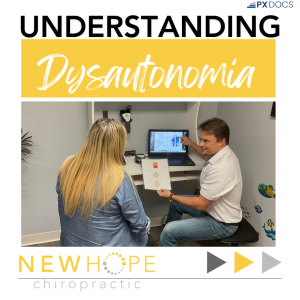Dysautonomia and Chiropractic Care
Dysautonomia is a condition that affects the autonomic nervous system, which controls nearly every function in our body, from digestion and immune response to mood regulation and physical movement. Yet, many parents and even some medical professionals may not fully understand dysautonomia, which is why it often goes undiagnosed and untreated.

Unfortunately, standard medical evaluations typically don't focus on the function of the nervous system. Tests like blood work or imaging (X-rays, MRIs, CT scans) look at chemistry or physical structures, but they don't provide insight into how well the nervous system is operating. That's where we come in to help.
What Is Dysautonomia?
Dysautonomia occurs when the autonomic nervous system becomes unbalanced, affecting the body’s ability to regulate vital functions. The autonomic nervous system has two sides: the sympathetic nervous system (the "gas pedal") and the parasympathetic nervous system (the "brake"). When dysautonomia sets in, the "gas pedal" is constantly stuck in overdrive, leading to symptoms like:
Anxiety
ADHD
Sleep disturbances
Gut issues
Fatigue
Brain fog
As a result, addressing dysautonomia is crucial for improving overall health and well-being. But how can you tell if your child is suffering from it?
The Root Causes of Dysautonomia
Dysautonomia is most commonly caused by stress on the nervous system. Stress can come in many forms, including trauma during pregnancy, difficult birth experiences (e.g., C-sections, forceps), early childhood infections, exposure to environmental toxins, and even emotional stress.
All of these factors can disrupt the autonomic nervous system, leading to imbalances in vital functions like digestion, sleep, and mood regulation. In children, these imbalances often present as issues like chronic ear infections, digestive problems, poor concentration, and behavioral challenges.
Dysautonomia and Digestive Health
One of the most common symptoms of dysautonomia in children is digestive dysfunction. Dysautonomia can significantly decrease gut motility, which refers to the movement of food and waste through the digestive tract. When motility is impaired, symptoms like reflux, constipation, colic, and stomachaches can arise.
As the autonomic nervous system loses its balance, digestive health takes a backseat. This is where chiropractic care comes in. By addressing the underlying neurological issues, we can help restore balance to the gut, alleviate digestive discomfort, and promote overall digestive health.
Impact on Immune Function
Another critical area affected by dysautonomia is the immune system. The autonomic nervous system plays a key role in regulating immune function, so when it's out of balance, it can lead to frequent illnesses, allergies, sinus infections, and respiratory issues like asthma.
Children with dysautonomia may struggle to recover from illnesses, requiring longer recovery times. Their immune systems become compromised, making them more susceptible to infections and conditions that seem to linger. By addressing the root cause of dysautonomia, we can help support a child’s immune system and prevent recurring issues.
Mental and Emotional Health
Dysautonomia is also linked to a variety of mental health challenges, particularly in children and teens. Issues like ADHD, anxiety, and depression are often rooted in an imbalanced nervous system. Because the autonomic nervous system also controls mood, focus, and emotional regulation, dysautonomia can make it difficult for kids to manage their emotions, stay focused, and engage socially.
When the nervous system is constantly stuck in a "fight-or-flight" mode, children experience emotional highs and lows that are difficult to regulate. Through chiropractic care, we can help calm the nervous system and provide the support needed for improved mood and emotional well-being.
The Role of Chiropractic Care in Treating Dysautonomia
The most effective way to address dysautonomia is through neurologically-focused chiropractic care. Chiropractic adjustments target the nervous system, helping to relieve stress, restore balance, and support the parasympathetic (rest-and-digest) side of the system.
At our office, we use advanced INSiGHT Scans to measure the levels of stress and subluxation (misalignment) in your child's nervous system. These scans help us pinpoint where the dysfunction is occurring, allowing us to create a customized care plan designed to restore balance to the autonomic nervous system.
The Power of Chiropractic Adjustments
Chiropractic care doesn’t just treat symptoms; it addresses the root cause of dysautonomia by removing nervous system interference. As we correct subluxations and support the nervous system, we help activate the parasympathetic side of the nervous system, which controls digestion, immune function, emotional regulation, and overall health.
This process allows children to thrive without relying on medications. By addressing the stress and imbalances in the nervous system, chiropractic care can help alleviate many of the symptoms of dysautonomia, leading to better digestion, immune function, emotional balance, and overall well-being.
Next Steps for Your Child
If your child is struggling with symptoms like anxiety, ADHD, digestive issues, or sleep disturbances, it could be a sign of dysautonomia. The first step in addressing this issue is getting a thorough evaluation of your child’s nervous system. We use advanced scanning technology to locate areas of stress and dysfunction, allowing us to create a targeted treatment plan.
If you’re ready to learn more about dysautonomia and how it may be affecting your child, give us a call today. We’re here to help your child overcome stress and thrive with a healthy, balanced nervous system.
Ready to take the next step? Schedule a consultation with us to get started on the path to healing.
To learn more, watch this video: https://youtu.be/EO0UjCUi29Y
Your child's health begins with their nervous system—let’s help them thrive!

